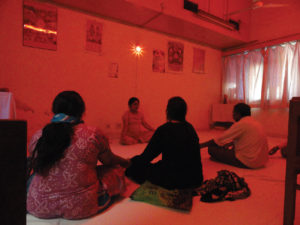Reduce Menopausal Symptoms, Anxiety, and Depression during Menopause with Mindfulness
By John M. de Castro, Ph.D.
“Mindfulness cannot entirely remove the symptoms of menopause, but it can help you deal with them in a calmer and more compassionate way – and self compassion boosts mental health.” – Karita Cullen
Menopause occurs in the 40s and 50s in most women, on average at 51 years of age. It is a natural physical process that marks the end of the menstrual cycle. The symptoms that occur over the years preceding menopause include irregular periods, vaginal dryness, hot flashes, chills
night sweats, sleep problems, mood changes, weight gain and slowed metabolism, thinning hair and dry skin, and loss of breast fullness. This is a natural process that is healthy and needs to occur. So, treatments are designed for symptomatic relief and include drugs and hormone treatments.
Mindfulness training may be a more natural treatment for the symptoms of menopause. Indeed, the mindful practice of yoga has been shown to improve the cardiac symptoms of menopause. It is important to study the effectiveness of other mindfulness practices in relieving these symptoms. In today’s Research News article “Mindfulness-Based Stress Reduction (MBSR) or Psychoeducation for the Reduction of Menopausal Symptoms: A Randomized, Controlled Clinical Trial.” (See summary below or view the full text of the study at: https://www.ncbi.nlm.nih.gov/pmc/articles/PMC5919973/ ), Wong and colleagues examine the effectiveness for the treatment of menopausal symptoms of a Mindfulness-Based Stress Reduction (MBSR) program, which includes meditation, yoga, and body scan practices.
They recruited women 40-60 years of age who were experiencing menopausal symptoms. They were randomly assigned to receive either Mindfulness-Based Stress Reduction (MBSR) training of once-a-week 2.5-hour sessions for 8 weeks or Menopausal education on a similar schedule. Both groups were encouraged to practice at home for 40 minutes daily. They were measured before and after training and 3 and 6 months later for menopausal symptoms, perceived stress, health related quality of life, and mindfulness.
They found that both groups had significant reductions in menopausal symptoms at all follow-up measurements including the 6-month follow-up, but the MBSR group had significantly greater improvement than the menopausal education group. In addition, the MBSR group had significantly greater reductions in anxiety and depression at the follow-up measurements. Hence, MBSR appears to produce greater improvements in menopausal symptoms than an active control condition.
Mindfulness-Based Stress Reduction (MBSR) is a complex program including, meditation, yoga, and body scan practices. In the present study, it cannot be determined which of these components or combinations of components are effective and which are not. It has been previously shown, however, that yoga practice improves the cardiac symptoms of menopause. So, it would seem likely that at least the yoga component is effective. It remains for future research to determine whether meditation and body scan are necessary or sufficient to relieve the symptoms of menopause. Regardless, it is clear that the complex of practices of MBSR has beneficial effects for women undergoing menopause.
So, reduce menopausal symptoms, anxiety, and depression during menopause with mindfulness.
“The degree of bother reported from hot flashes and night sweats in the mindfulness group decreased over time, indicating time and persistence using mindfulness techniques may be key to obtaining beneficial results.” – Lena Suhaila
CMCS – Center for Mindfulness and Contemplative Studies
This and other Contemplative Studies posts are also available on Google+ https://plus.google.com/106784388191201299496/posts and on Twitter @MindfulResearch
Study Summary
Carmen Wong, Benjamin Hon-Kei Yip, Ting Gao, Kitty Yu Yuk Lam, Doris Mei Sum Woo, Annie Lai King Yip, Chloe Yu Chin, Winnie Pui Yin Tang, Mandy Mun Tse Choy, Katrina Wai Key Tsang, Suzanne C. Ho, Helen Shuk Wah Ma, Samuel Yeung Shan Wong. Mindfulness-Based Stress Reduction (MBSR) or Psychoeducation for the Reduction of Menopausal Symptoms: A Randomized, Controlled Clinical Trial. Sci Rep. 2018; 8: 6609. Published online 2018 Apr 26. doi: 10.1038/s41598-018-24945-4
Abstract
Psychological and behavioural interventions may be effective in reducing menopause-related symptoms. This randomized controlled trial aimed to evaluate the effectiveness of Mindfulness-based Stress Reduction (MBSR) in reducing menopause-related symptoms by comparing with an active control group, the menopause education control (MEC). Symptomatic peri-menopausal and post-menopausal women with mild to moderate symptoms were recruited. The primary outcome was overall menopausal symptoms measured by modified Greene Climacteric Scale (GCS). Secondary outcomes include subscales of the GCS perceived stress, mindfulness and health related Quality of Life. All outcome measures were collected at baseline, 2 months (immediately post intervention), 5 and 8 months (3 and 6 months post intervention respectively). Both MBSR (n = 98) and MEC (n = 99) groups reported a reduction in total GCS score at 8 months. Between group analysis show significant symptom score reduction in MBSR group on Anxiety and Depression subscales of GCS. No differences were found between groups on other GCS subscales and majority of the secondary outcome measures. The findings show that menopausal symptoms in both MBSR and MEC significantly reduced over the study period. MBSR show a greater reduction of psychological symptoms of depression and anxiety above active controls but do not reduce other somatic, urogenital and vasomotor symptoms.









